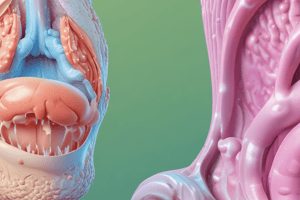Podcast
Questions and Answers
Which of the following is a consequence of urinary incontinence?
Which of the following is a consequence of urinary incontinence?
- Increased independence
- Enhanced activity level
- Improved self-esteem
- Depression (correct)
What is the main objective of identifying clinical presentations of urinary incontinence?
What is the main objective of identifying clinical presentations of urinary incontinence?
- To create a monitoring plan
- To assess institutional placement
- To implement self-care strategies
- To apply appropriate treatment (correct)
What should be asked to bring up the subject of urinary incontinence?
What should be asked to bring up the subject of urinary incontinence?
- Do you ever lose control of your urine? (correct)
- Are you incontinent?
- Have you experienced urinary discomfort?
- Do you frequently visit the bathroom?
What does the 'P' in 'History of Present Illness' stand for in the context of urinary incontinence?
What does the 'P' in 'History of Present Illness' stand for in the context of urinary incontinence?
What should be the focus when formulating a monitoring plan for the prescribed regimen for urinary incontinence?
What should be the focus when formulating a monitoring plan for the prescribed regimen for urinary incontinence?
What is the term used to refer to urinary incontinence primarily in children?
What is the term used to refer to urinary incontinence primarily in children?
What is a major risk factor for urinary incontinence?
What is a major risk factor for urinary incontinence?
Which type of incontinence is characterized by an overactive bladder?
Which type of incontinence is characterized by an overactive bladder?
What type of therapy generally works better than medication for stress and urge incontinence?
What type of therapy generally works better than medication for stress and urge incontinence?
What is a potential treatment for urinary incontinence?
What is a potential treatment for urinary incontinence?
Flashcards
Depression
Depression
A common symptom of urinary incontinence that can significantly impact a person's quality of life.
Identifying clinical presentations of urinary incontinence
Identifying clinical presentations of urinary incontinence
To provide the best possible care based on the specific type and severity of urinary incontinence.
Asking about urinary incontinence
Asking about urinary incontinence
A sensitive yet direct approach to addressing urinary incontinence with a patient.
Provocation or palliation (P in HPI)
Provocation or palliation (P in HPI)
Signup and view all the flashcards
Monitoring plan for urinary incontinence treatment
Monitoring plan for urinary incontinence treatment
Signup and view all the flashcards
Enuresis
Enuresis
Signup and view all the flashcards
Pregnancy
Pregnancy
Signup and view all the flashcards
Urge incontinence
Urge incontinence
Signup and view all the flashcards
Behavioral therapy
Behavioral therapy
Signup and view all the flashcards
Pelvic floor muscle training
Pelvic floor muscle training
Signup and view all the flashcards




